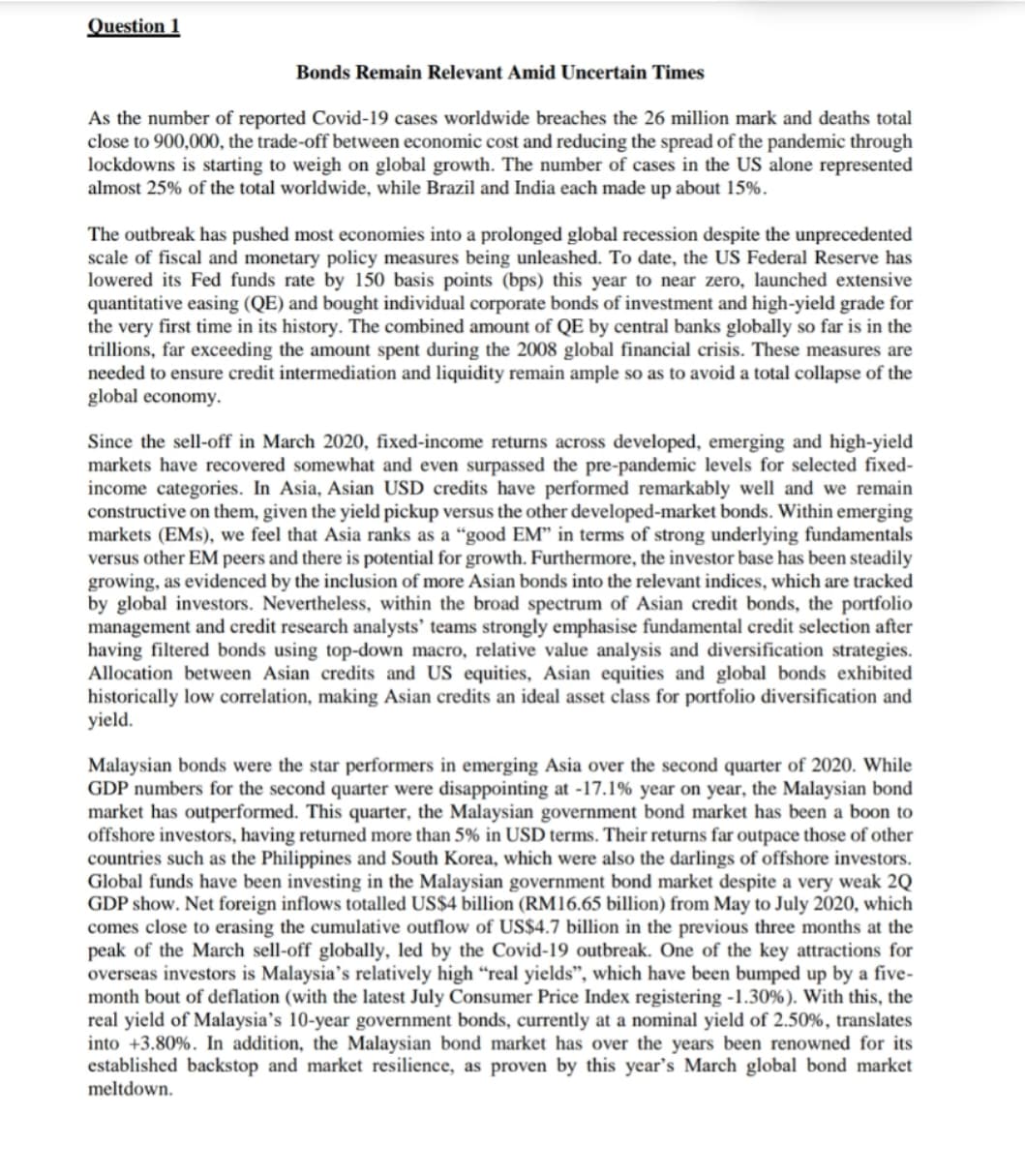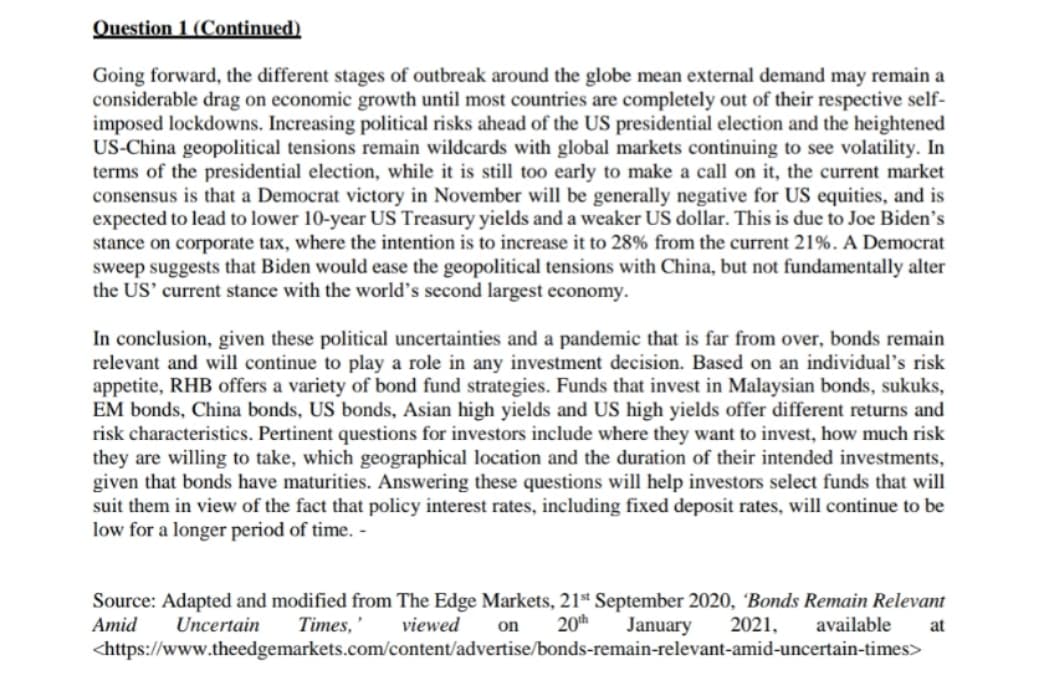Chapter1: Making Economics Decisions
Section: Chapter Questions
Problem 1QTC
Related questions
Question
(c) “Within the broad spectrum of Asian credit bonds, the
Define “diversified portfolio”. With relevant examples, discuss any THREE (3) benefits of diversified portfolio strategies.

Transcribed Image Text:Question 1
Bonds Remain Relevant Amid Uncertain Times
As the number of reported Covid-19 cases worldwide breaches the 26 million mark and deaths total
close to 900,000, the trade-off between economic cost and reducing the spread of the pandemic through
lockdowns is starting to weigh on global growth. The number of cases in the US alone represented
almost 25% of the total worldwide, while Brazil and India each made up about 15%.
The outbreak has pushed most economies into a prolonged global recession despite the unprecedented
scale of fiscal and monetary policy measures being unleashed. To date, the US Federal Reserve has
lowered its Fed funds rate by 150 basis points (bps) this year to near zero, launched extensive
quantitative easing (QE) and bought individual corporate bonds of investment and high-yield grade for
the very first time in its history. The combined amount of QE by central banks globally so far is in the
trillions, far exceeding the amount spent during the 2008 global financial crisis. These measures are
needed to ensure credit intermediation and liquidity remain ample so as to avoid a total collapse of the
global economy.
Since the sell-off in March 2020, fixed-income returns across developed, emerging and high-yield
markets have recovered somewhat and even surpassed the pre-pandemic levels for selected fixed-
income categories. In Asia, Asian USD credits have performed remarkably well and we remain
constructive on them, given the yield pickup versus the other developed-market bonds. Within emerging
markets (EMs), we feel that Asia ranks as a “good EM" in terms of strong underlying fundamentals
versus other EM peers and there is potential for growth. Furthermore, the investor base has been steadily
growing, as evidenced by the inclusion of more Asian bonds into the relevant indices, which are tracked
by global investors. Nevertheless, within the broad spectrum of Asian credit bonds, the portfolio
management and credit research analysts’ teams strongly emphasise fundamental credit selection after
having filtered bonds using top-down macro, relative value analysis and diversification strategies.
Allocation between Asian credits and US equities, Asian equities and global bonds exhibited
historically low correlation, making Asian credits an ideal asset class for portfolio diversification and
yield.
Malaysian bonds were the star performers in emerging Asia over the second quarter of 2020. While
GDP numbers for the second quarter were disappointing at -17.1% year on year, the Malaysian bond
market has outperformed. This quarter, the Malaysian government bond market has been a boon to
offshore investors, having returned more than 5% in USD terms. Their returns far outpace those of other
countries such as the Philippines and South Korea, which were also the darlings of offshore investors.
Global funds have been investing in the Malaysian government bond market despite a very weak 2Q
GDP show. Net foreign inflows totalled US$4 billion (RM16.65 billion) from May to July 2020, which
comes close to erasing the cumulative outflow of US$4.7 billion in the previous three months at the
peak of the March sell-off globally, led by the Covid-19 outbreak. One of the key attractions for
overseas investors is Malaysia's relatively high “real yields", which have been bumped up by a five-
month bout of deflation (with the latest July Consumer Price Index registering -1.30%). With this, the
real yield of Malaysia's 10-year government bonds, currently at a nominal yield of 2.50%, translates
into +3.80%. In addition, the Malaysian bond market has over the years been renowned for its
established backstop and market resilience, as proven by this year's March global bond market
meltdown.

Transcribed Image Text:Question 1 (Continued)
Going forward, the different stages of outbreak around the globe mean external demand may remain a
considerable drag on economic growth until most countries are completely out of their respective self-
imposed lockdowns. Increasing political risks ahead of the US presidential election and the heightened
US-China geopolitical tensions remain wildcards with global markets continuing to see volatility. In
terms of the presidential election, while it is still too early to make a call on it, the current market
consensus is that a Democrat victory in November will be generally negative for US equities, and is
expected to lead to lower 10-year US Treasury yields and a weaker US dollar. This is due to Joe Biden's
stance on corporate tax, where the intention is to increase it to 28% from the current 21%. A Democrat
sweep suggests that Biden would ease the geopolitical tensions with China, but not fundamentally alter
the US' current stance with the world's second largest economy.
In conclusion, given these political uncertainties and a pandemic that is far from over, bonds remain
relevant and will continue to play a role in any investment decision. Based on an individual's risk
appetite, RHB offers a variety of bond fund strategies. Funds that invest in Malaysian bonds, sukuks,
EM bonds, China bonds, US bonds, Asian high yields and US high yields offer different returns and
risk characteristics. Pertinent questions for investors include where they want to invest, how much risk
they are willing to take, which geographical location and the duration of their intended investments,
given that bonds have maturities. Answering these questions will help investors select funds that will
suit them in view of the fact that policy interest rates, including fixed deposit rates, will continue to be
low for a longer period of time. -
Source: Adapted and modified from The Edge Markets, 21* September 2020, Bonds Remain Relevant
Amid
Uncertain
Times, '
viewed
20th
January
2021,
available
at
on
<https://www.theedgemarkets.com/content/advertise/bonds-remain-relevant-amid-uncertain-times>
Expert Solution
This question has been solved!
Explore an expertly crafted, step-by-step solution for a thorough understanding of key concepts.
Step by step
Solved in 2 steps with 1 images

Knowledge Booster
Learn more about
Need a deep-dive on the concept behind this application? Look no further. Learn more about this topic, economics and related others by exploring similar questions and additional content below.Recommended textbooks for you


Principles of Economics (12th Edition)
Economics
ISBN:
9780134078779
Author:
Karl E. Case, Ray C. Fair, Sharon E. Oster
Publisher:
PEARSON

Engineering Economy (17th Edition)
Economics
ISBN:
9780134870069
Author:
William G. Sullivan, Elin M. Wicks, C. Patrick Koelling
Publisher:
PEARSON


Principles of Economics (12th Edition)
Economics
ISBN:
9780134078779
Author:
Karl E. Case, Ray C. Fair, Sharon E. Oster
Publisher:
PEARSON

Engineering Economy (17th Edition)
Economics
ISBN:
9780134870069
Author:
William G. Sullivan, Elin M. Wicks, C. Patrick Koelling
Publisher:
PEARSON

Principles of Economics (MindTap Course List)
Economics
ISBN:
9781305585126
Author:
N. Gregory Mankiw
Publisher:
Cengage Learning

Managerial Economics: A Problem Solving Approach
Economics
ISBN:
9781337106665
Author:
Luke M. Froeb, Brian T. McCann, Michael R. Ward, Mike Shor
Publisher:
Cengage Learning

Managerial Economics & Business Strategy (Mcgraw-…
Economics
ISBN:
9781259290619
Author:
Michael Baye, Jeff Prince
Publisher:
McGraw-Hill Education